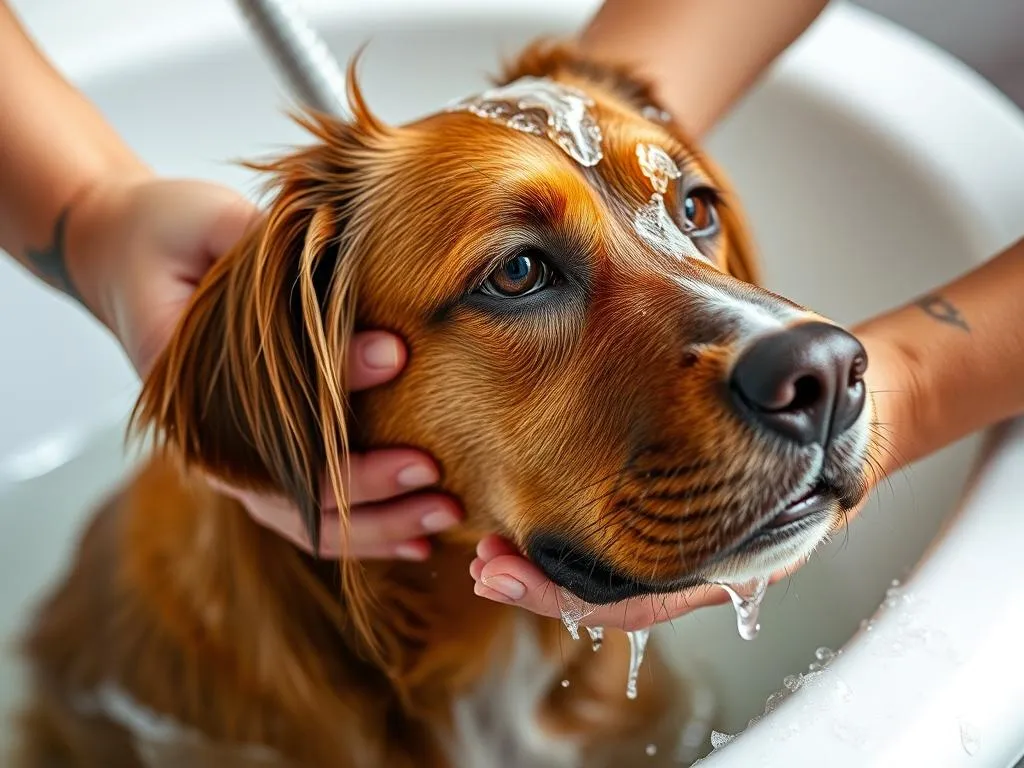
Introduction
Caring for a dog involves more than just feeding and walking them; it includes a comprehensive approach to their health and well-being. One of the essential aspects of dog health care is regular bathing, which plays a crucial role in maintaining their hygiene and comfort. This article will focus on how to give a dog a bath, ensuring that you have all the necessary information and techniques to make bath time a smooth experience for both you and your furry friend.
Understanding the Importance of Bathing Your Dog
Health Benefits
Bathing your dog isn’t just about keeping them looking good; it has significant health benefits. Regular baths help remove dirt, allergens, and parasites that can accumulate in their fur and skin. This process can prevent skin infections and unpleasant odors, promoting a healthier environment for your pet.
Behavioral Benefits
Bathing can also have positive behavioral benefits. For many dogs, regular bathing reduces anxiety and stress related to grooming. It can be a bonding experience between you and your dog, strengthening your relationship. A calm, positive bath experience can help your dog associate bath time with comfort rather than fear.
Breed-Specific Bathing Needs
Different dog breeds have varying coat types and needs. For example, short-haired breeds may require less frequent baths than long-haired or hypoallergenic breeds. Understanding your dog’s specific bathing requirements is crucial for their health. Here’s a brief overview:
- Short-haired breeds (e.g., Beagles, Boxers): Bathe every 2-3 months.
- Long-haired breeds (e.g., Golden Retrievers, Collies): Bathe every 4-6 weeks.
- Hypoallergenic breeds (e.g., Poodles, Bichon Frises): Bathe every 4-6 weeks, with regular brushing in between.
Preparing for Bath Time
Gathering Supplies
Before you start, it’s essential to gather all necessary supplies. Here’s a checklist to help you prepare:
- Dog shampoo (preferably hypoallergenic)
- Towels
- Brushes (appropriate for your dog’s coat type)
- Non-slip mat (for the bathing area)
- Cup or handheld sprayer (for wetting and rinsing)
- Cotton balls (for ear protection)
Choosing the Right Location
Decide whether to bathe your dog indoors or outdoors. Indoor baths can be more controlled, especially in colder weather. However, outdoor bathing can be a fun experience for your dog in warm weather. Consider your dog’s safety and comfort during the bath. Make sure the area is free from hazards and that your dog feels secure.
Preparing Your Dog
Before the bath, it’s helpful to calm your dog. You can do this by speaking softly and offering treats. A pre-bath brush can help remove loose hair and mats, making the bathing process easier. This step will not only reduce shedding but also make your dog more comfortable during the bath.
Step-by-Step Guide on How to Give a Dog a Bath
Step 1: Wetting the Dog
Start by wetting your dog thoroughly. Use lukewarm water to avoid startling them. If your dog is nervous, you can use a cup or handheld sprayer to gently wet their coat, starting from the back and moving forward. Avoid spraying water directly on their face. The general rule is to use a low-pressure setting to ensure comfort.
Step 2: Applying Shampoo
Choosing a suitable shampoo is crucial. Opt for a dog-specific shampoo, as human products can irritate their skin. Apply a small amount of shampoo to your hands and lather it into your dog’s coat, starting from the neck and working your way down. Be gentle around sensitive areas like the face, ears, and tail.
Step 3: Rinsing Thoroughly
Rinsing is the most critical stage. Make sure to remove all shampoo residues, as leftover product can lead to skin irritation. Use the cup or sprayer to rinse thoroughly, checking for any bubbles in the coat. It’s essential to ensure that no residue is left behind, especially around the ears and underarms.
Step 4: Drying Your Dog
After rinsing, it’s time to dry your dog. You can use towels to absorb excess water, but be patient, as this process may take time. If your dog is comfortable with it, you can use a blow dryer on a low setting to speed up drying. Ensure the dryer is at a safe distance from their skin to avoid burns. Alternatively, allow your dog to air dry in a warm, draft-free area.
Post-Bath Care
Inspecting for Health Issues
After the bath, take a moment to inspect your dog for any health issues. Look for signs of redness, irritation, or unusual lumps on their skin. Regular skin checks can help you catch potential problems early, ensuring your dog stays healthy.
Maintaining Coat Health
To maintain a healthy coat, establish a brushing routine after bathing. Regular brushing helps remove dead hair and distribute natural oils, promoting a shiny coat. Consider using dog-friendly conditioners or sprays to enhance coat health and manageability.
Establishing a Bathing Routine
How often you should bathe your dog depends on their activity level, coat type, and lifestyle. While some dogs may need baths every few weeks, others may only require them every couple of months. Customizing a bathing schedule based on your dog’s specific needs will help maintain their hygiene without overdoing it.
Common Mistakes to Avoid
Using Human Products
One of the biggest mistakes is using human shampoos and conditioners on dogs. These products can disrupt the pH balance of your dog’s skin, leading to irritation and other health issues. Always opt for pet-specific products designed for their unique skin needs.
Overbathing
While regular baths are essential, overbathing can be harmful. Bathing too frequently can strip your dog’s coat of natural oils, leading to dry skin and irritation. Stick to a routine that suits your dog’s needs without overdoing it.
Neglecting Ears and Eyes
During bath time, it’s easy to focus solely on the coat. However, don’t neglect your dog’s ears and eyes. Be cautious when rinsing near these sensitive areas, and consider using cotton balls in their ears to prevent water from entering. After the bath, wipe around their eyes with a damp cloth to remove any debris.
Alternatives to Bathing
Waterless Dog Shampoo
If your dog dislikes water or it’s impractical to give a full bath, consider using waterless dog shampoos. These products can effectively clean your dog’s coat without the need for rinsing. They come in various forms, such as sprays or foams, and can be a convenient option for quick clean-ups.
Professional Grooming Services
Sometimes, it may be best to leave bathing and grooming to the professionals. If your dog requires a thorough cleaning or has a complicated coat type, consider professional grooming services. These experts can handle your dog’s needs and provide additional services like nail trimming and ear cleaning.
Conclusion
In summary, regular bathing is a vital component of dog health care. It contributes to your pet’s physical health, emotional well-being, and overall hygiene. By learning how to give a dog a bath properly, you can ensure a positive experience for both you and your cherished companion. Establish a bathing routine that fits your dog’s needs, and remember that a calm, loving environment during bath time can make a world of difference.
By following the guidelines in this article, you’ll not only keep your dog clean and healthy but also strengthen your bond with them through the grooming process. Happy bathing!









